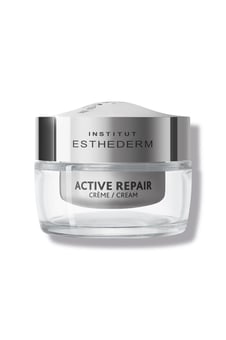ACTIVE REPAIR CRÈME CORRECTRICE RIDES
INSTITUT ESTHEDERM

ACTIVE REPAIR CRÈME CORRECTRICE RIDES
INSTITUT ESTHEDERM
ACTIVE REPAIR CREME CORRECTRICE RIDES
Verzorging Gelaat, Hals
INSTITUT ESTHEDERM

INSTITUT ESTHEDERM
ACTIVE REPAIR CREME CORRECTRICE RIDES
Verzorging Gelaat, Hals
Al onze ingrediënten zijn speciaal geselecteerd op efficiëntie. U vindt hier een overzicht van alle ingrediënten geklasseerd in families volgens hun functie.
Time Control System patent
Hydraterend
Antirimpel
Voedend
Keratolytisch
Antioxidant
Matterend
Textuur
Geur & parfum
Bescherming van het product
Bewaarmiddel.
De ingrediënten van onze producten zijn geselecteerd op basis van strenge dermatologische criteria en aanbevolen door onafhankelijke toxicologische experts. Actieve bestanddelen zijn geklasseerd in drie belangrijke categorieën en ontdek hun aard, rol en origine door op hun naam te klikken.
Hier worden de ingrediënten, die bijdragen tot de verwachte doeltreffendheid van het product, gegroepeerd: degenen die de biologische huidmechanismen optimaliseren of in stand houden (zoals hydratatie, regeneratie, lipideherstellende werking), en degenen met een zeer specifieke fysisch-chemische werking (exfoliërend, matterend, zonnefilters...).
De vermelde ingrediënten zijn deze die de meest recente formule van het product bevat. Tussen productie en distributie kan wat tijd verstrijken en wij raden u dan ook aan de lijst van ingrediënten op de verpakking te raadplegen.

Voor welk huidtype is dit product bedoeld? Hoe wordt ACTIVE REPAIR CRÈME CORRECTRICE RIDES aangebracht? Wanneer gebruiken? Welke formaten zijn beschikbaar?

Onze transparante aanpak
Welkom bij onze laboratoria in Aix-en-Provence.
Ontdek onze unieke wetenschappelijke aanpak, ecobiologie.